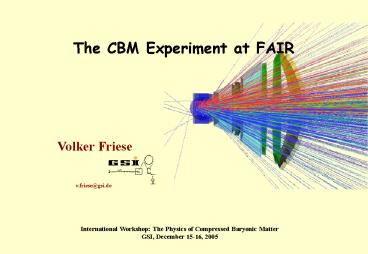The CBM Experiment at FAIR - PowerPoint PPT Presentation
1 / 21
Title:
The CBM Experiment at FAIR
Description:
seems to work well for fast muons from charmonium. The Muon Option: Low-mass ... This will open up a new domain of observables not measured before at FAIR ... – PowerPoint PPT presentation
Number of Views:39
Avg rating:3.0/5.0
Title: The CBM Experiment at FAIR
1
The CBM Experiment at FAIR
International Workshop The Physics of Compressed
Baryonic Matter GSI, December 15-16, 2005
2
The CBM Experiment
Tracking STS, TRD Vertexing STS Hadron ID
TOF Electron ID RICH, TRD, ECAL ?, n ECAL
3
Conditions for CBM
- Heavy-ion beams up to 35 AGeV
- Light ion beams up to 45 AGeV
- proton beam up to 90 GeV
- Ion beam intensity 109/s!
Access to rarest probes charm near threshold,
low-mass dielectrons Huge experimental
challenges Detection and read-out
speed Radiation hardness Precision rate
capability fast online event processing
Detector RD under way
4
Physics topics
deconfinement at high ?B
strangeness (K, ?, S, ?, O) charm (J/?, D) flow
in-medium properties of hadrons
?, ?, f ? ee- open charm
critical point
fluctuations
5
Observables
6
CBM Feasibility Studies
- D0?pK- (D?ppK)
- J/??ee-
- J/??µµ-
- ?,?,f?ee-
- ??p-p, ?-??p-, O-??K-
- K/p fluctuations
- Simulation levels
- pure Monte-Carlo (principal feasibility
acceptance, estimated yields) - anticipated detector response, track and vertex
reconstruction - full detector simulation including global
tracking and PID
7
Performance of STS for D0 Mesons
invariant pK- mass
vertex resolution
without PID
similar studies for D (larger ct, better vertex,
3-particle combinatorics)
8
Open Charm Questions
What should me measure yields, spectra,
flow? How close to threshold do we have to
go? What about charmed baryons? (?c, t 60 µm,
very challenging!)
Huge impact on design of STS!
9
The Silicon Tracking System
"minimal setup" 3 pixel stations 4 strip
stations
Critical issues matgerial budget precision radiat
ion hardness speed
momentum resolution lt 1
alternative options (including hybrid pixels for
track seed) under investigation
10
Charmonium
Electrons identified in TRD ( RiCH) Signal
extraction straightforward Requires pion
suppression gt 103 Requires highest beam
intensities
J/?
1010 events
11
Low-mass Dielectrons
ee- sources
Main background sources pion Dalitz, ?
conversion Requires sophisticated rejection
strategy
12
Low-mass Dielectrons (ctd.)
S/B about 1 for ?,f small for low-mass
continuum requires good modelling of
combinatorial background pion rejection better
than 103 reduced magnetic field
13
K/p Fluctuations
4 ? acceptance(UrQMD) identified particles
K/ ? 3.2 ? 0.3 2.6 ? 0.6
p/ ? -5.3 ? 0.07 -5.9 ? 0.1
Acceptance and kaon ID seems suited for
fluctuation measurement
14
The Muon Option
Combination of carbon and iron absorbers with
detectors
15
The Muon Option J/?
seems to work well for fast muons from charmonium
16
The Muon Option Low-mass Vector Mesons
?
reasonable for mesons with vacuum masses low-mass
continuum not covered further optimisation ongoing
17
Conclusions so far
- CBM seems conceptually to be able to measure the
desiredobservables, provided the required
detector performances can be reached. - Different observables require
- different running conditions
- highest interaction rate (107/s), highly
triggered charm - untriggered (several 104/s) all others
- modified setups low-mass dielectrons
- target position
- magnetic field
- different setup muons
18
Summary
- Feasibility studies show that CBM is conceptually
able to measure its key observables provide the
design performance is reached. - Detector RD is under way to meet the unprecented
requirements. - This will open up a new domain of observables not
measured before at FAIR energies or in heavy-ion
reactions at all. - To improve our knowledge of QCD with CBM, we need
quantitative predictions from theory, such that
data can rule out or confirm scenarios. - Requirements of theory on measurements of
observables will have a huge impact on the final
detector design. - We would like to have a priority list of
observables, which are expected to answer key
questions of theory.
19
(No Transcript)
20
(No Transcript)
21
(No Transcript)

